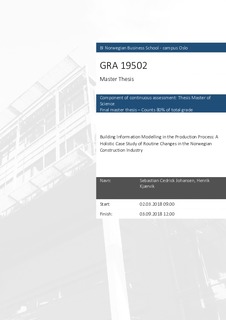| dc.description.abstract | In response to the lack of research on, and the calls to advance researchers’
understanding of, the application of Building Information Modelling (BIM) at the
construction site, this thesis aims to identify how the implementation of BIM in
the production process has changed the routines in construction projects. The
research question is explored through a holistic case study of two construction
projects at Veidekke, Norway’s largest construction and contractor company,
which applied the BIM software to different degrees at the construction site. The
theoretical basis for this study is organizational change, routine change, and
sociomateriality. The findings indicate several routine changes and improved
efficiency on-site as a consequence of the implementation of BIM in the
production process. Further, the study identified the emergence of change agents
in the organization, who plays a vital role in implementing and promoting the
BIM software. The implementation of BIM enables change agents to educate the
workers in applying the software and to develop new solutions which create a
shift in the routines. Further, this thesis proposes on-site BIM as a boundary
object that works as a platform for discussion, also enabling actors to apply their
common interpretation of the data presented and thereby changing their routines.
Summarized, this thesis discusses the consequences of implementing BIM
software in the production process at the construction site. The practical and
theoretical implications are discussed. | nb_NO |

